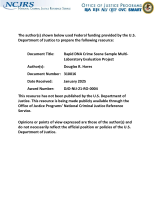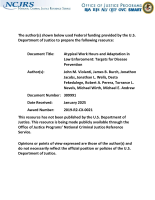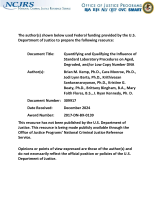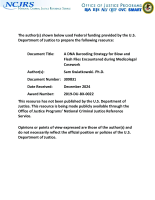DNA (Deoxyribonucleic Acid)
An Affinity-Free, Centrifugal Microfluidic System for Rapid, Automated Differential Extraction
Rapid DNA Crime Scene Sample Multi-Laboratory Evaluation Project
Atypical Work Hours and Adaptation in Law Enforcement: Targets for Disease Prevention
30 Years of the Violence Against Women Act: Endurance, Expansion, and the Next Era
Summary of a plenary panel from the 2024 NIJ Research Conference
The Y-Chromosome in Forensic and Public Health Genetics
DNA Purification in Microfluidic Systems for Clinical and Forensic Application
Quantifying and Qualifying the Influence of Standard Laboratory Procedures on Aged, Degraded, and/or Low Copy Number DNA
Optimizing the Analysis of DNA from Burned Bone Using Ancient DNA Techniques
Advancing Forensic DNA Profiling Through Microchip Technology
Mitochondrial DNA Analysis by Denaturing High-Performance Liquid Chromatography for the Characterization and Separation of Mixtures in Forensic Samples
The Study of Tissue-Specific DNA Methylation as a Method for the Epigenetic Discrimination of Forensic Samples
Identification of Features for Enzymatic Catalysis and Their Application Towards Enzyme Engineering
The Collection, Preservation, and Processing of DNA Samples from Decomposing Human Remains for More Direct Disaster Victim Identification (DVI)
Characterizing the Natural Genetic and Epigenetic Diversity of Human Populations
Computational methods for the interpretation of forensic DNA samples
Physical and Biochemical Factors Affecting the Recovery and Analysis of DNA from Human Skeletal Remains
A DNA Barcoding Strategy for Blow and Flesh Flies Encountered during Medicolegal Casework
Analyzing and interpreting deoxyribonucleic acid from multiple donors using a forensically relevant single-cell strategy
Direct Comparison of Body Fluid Identification Technologies
Forensic investigators now have more information on the performance of identification technologies for biological fluids.
Postmortem CT Scans Supplement and Replace Full Autopsies
As medical examiner and coroner offices nationwide face a severe shortage of forensic pathologists, New Mexico has pioneered the use of CT scans to reduce autopsy numbers and reduce costs.








